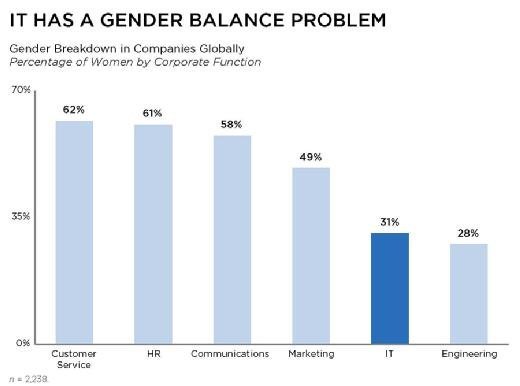
Rawpixel - Fotolia
Number of women working in IT to rise by 2020
The proportion of women choosing to work in the IT profession is set to increase over the next four years as businesses adopt digital technology, according to a major study by the CEB
The proportion of women choosing to work in the IT profession is set to increase over the next four years as businesses adopt digital technology, according to a major study by the CEB.
The CEB, a membership group for business executives, has predicted that the number of women choosing IT will increase between now and 2020, as marketing departments, finance departments and other areas of the business recruit more people with IT skills.
The study found the proportion of women working across companies around the world in information technology today is 31%. Only engineering attracts a smaller proportion of women (see chart below).
The picture is worse in the UK, where only 18% of people in computer-related roles are women, compared with 37% in mathematics and 62% in life and physical sciences, an analysis based on job advertisements revealed.
In future, IT departments will need to employ people with a wider range of skills, opening up new opportunities for women, Kris van Riper, practice leader at CEB told Computer Weekly.
“There will be more people in the IT team with marketing background, maybe digital marketers; more people with customer experience background; more people who are business analysts, who are getting requirements from customers; and project managers,” she said.
The trend follows a shift in the role of the IT department from a department that drives IT projects for business, to a department that acts as an advisor for other parts of the business that want to adopt digital technology.
Research shows that companies with a more equal balance between male and female employees, particularly at senior levels, are more successful than those that are more male dominated.
A study by McKinsey in 2010 found that companies with the highest representation of women on executive committees had, on average, a 47% higher return on equity.
And research by Credit Suisse found that companies with one or more women on the board had an average return on equity of 16%, compared with 12% for firms all-male boards.
“The number of women in UK boardrooms is still low. There is not only one cause or only one solution. There is not one thing that will work across all geographies. It’s a multifaceted problem,” said van Riper.
The problem is particularly acute in technology-focused professions, where it is both difficult to recruit women into technology roles and to encourage them to stay in technology.

“Technology occupations have a higher turnover rate of women than men. There are a number of factors. If they don’t have enough role models and don’t see enough opportunities, they will leave for other occupations,” said van Riper.
However there are simple steps that IT organisations can take to ensure that, over time, they develop a better gender balance in their workforce.
“These strategies that are proven, low cost and low complexity, and could be put in place by IT teams, without requiring multiple levels of approval from the HR team and the legal team,” said van Riper.
How to recruit more women into IT
The companies that are most successful at recruiting women don’t rely on word of mouth or personal contacts to advertise positions, but advertise vacancies as widely as possible, the CEB research revealed.
One IT leader, for example, told a CEB conference that he used to advertise vacancies on LinkedIn – until he audited his connections and discovered that 80% of his contacts were male.
“If you just rely on word of mouth, then 80% of your responses are going to be from men,” said van Riper. “Word of mouth simply reinforces existing networks.”
How to attract more women into IT
- Don’t rely on word of mouth to recruit; actively publicise all vacancies.
- Pursue diverse groups of candidates.
- Make your selection panels diverse.
Intel has increased the number of female candidates applying for posts by briefing its external recruitment agencies and, more recently, internal recruiters to advertise positions outside their existing recruitment networks.
Intel has seen a slow but steady increase in the number of women in the workforce, but finding a workforce balance is something that can’t happen overnight, said van Riper. “Intel has produced numbers – it has tracked higher numbers of women. The bad news is the numbers don’t change quickly,” she added.
Another hurdle for employers is that women are more reluctant to apply for posts than men if they don’t see themselves as meeting every requirement of the advertised job description.
“Two equally qualified people who read a job description are not equally likely to apply for it. Women will only apply if they believe they are 90% qualified, for men its substantially lower, at 60%” said van Riper.
One CIO told a conference run by the CEB that he makes a point of encouraging talented women on the IT team to apply for positions: “If I see qualified people, I ask them to apply.”

“Technology occupations have a higher turnover rate of women than men”
Kris van Riper, CEB
The wording on job advertisements can also make a huge difference. Use the phrase “drive enterprise change”, for example, and you are likely to attract male candidates. Replace it with “enable, co-ordinate and facilitate enterprise change”, which more or less means the same thing, and you are more likely to have equal numbers of men and women applying.
Making selection panels as diverse as possible costs nothing, and has been shown to enable companies to recruit a more diverse set of candidates.
It is important that the panel meets beforehand to create a decision-making framework for hiring, so they avoid unintentional bias, said van Riper.
“Make sure your panel mirrors desired workforce composition. Make sure every member of the team has input in decision-making,” she said. “And make sure candidates are interviewed by more than one team member.”
How to retain women in IT
CEB’s research showed that even when women have started out on an IT career, they are less likely to stay in an IT role than men – but there are simple steps companies can take to reduce the leaving rate.
“Flexiblity is one of the most under-appreciated retention tools for women. The freedom to work where and when you want, from home, in and away from the office,” said van Riper.
According to the CEB study, when female managers said they were unhappy with workplace flexibility only 17% planned to stay at their organisation. Of those that were satisfied with workplace flexibility, 37% intended to stay with their existing employer – a difference of 40%.
The research also revealed that having a flexible working policy is not enough. Many women failed to take up the flexible working options in their organisation, fearing that to do so would damage their career opportunities.
“It is not formally having the policy, it is whether people perceive they can use it. If they have a formal policy but people don’t use it because they don’t have the role models and can’t see other people using it, they don’t use it,” she said.
A number of companies have solved this problem by making flexible working the normal state for all employees, male, female, junior and senior. It is no longer a perk for high-fliers or a concession for people with family commitments.
One telecoms company which took this approach saw its employee engagement scores increase across all sections of the workforce, including among men, women and new starters, but particularly women.
“We know from our own research that workplace flexibility directly correlates with productivity, discretionary effort and intent to stay,” said van Riper.
Proportion of women in IT roles in the UK
IT project and programme managers 33% ............ ..........................................
IT specialist managers 24% ......................................................
Software development 11% ....... ...............................................
IT and telecoms directors 9% ...... ................................................
Source: CEB TalentNeuron research
There were other benefits too. The company found that more women applied for jobs with the company, and more existing female employees applied for internal promotions.
In the past, women were worried about a lifestyle trade-off in taking on a more demanding role, said van Riper.
For IT departments, having a diversified workforce will prove increasingly important over the next five years, as IT becomes pervasive throughout organisations.
“IT will need to engage with a broader set of people across the enterprise. A diverse workforce will help them better understand the opportunities and risks,” she said.
Van Riper advises women who want to pursue careers in IT to sound out potential career moves first with trusted colleagues or managers.
“Get perspective from others to check whether you are a suitable candidate. You don’t have to check every box, because you may be self-limiting,” she said.
It is also important for women to negotiate for flexible working as part of their benefits package.
“We want to see women self-advocating for whatever flexibility they need to stay. You can call it negotiation, self-advocacy, but it is about not being afraid to ask,” she said.
Read More from CEB
- Corporate IT budgets are expected to grow by just 2% in the coming year, with budgets for ‘keeping the lights on’ expected to surpass capital spending for the first time since 2009, finds CEB budget benchmark 2015-2016.
- CIOs are facing pressure from the board to roll out IT projects increasingly quickly. How can they do that without running unacceptable risks?
- IT budgets will grow at their slowest rate for four years in 2016, yet companies are spending more on digital technology.









